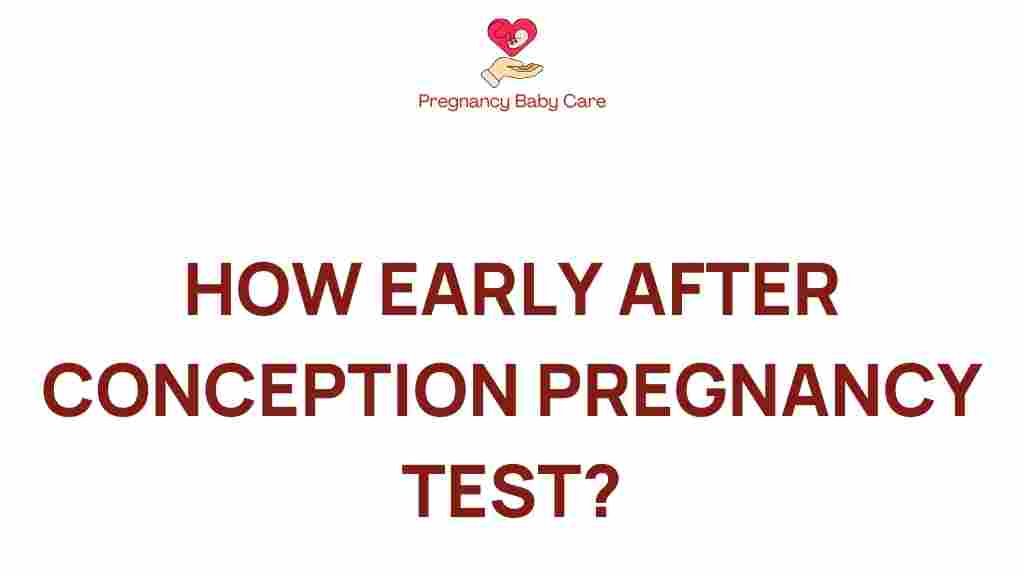The Surprising Timeline: When Can You Take a Pregnancy Test?
When it comes to discovering whether you are pregnant, timing is everything. The journey to conception can be filled with excitement, hope, and a bit of anxiety—especially when you’re waiting to take a pregnancy test. Understanding when to test for pregnancy, how hormones affect the results, and recognizing early pregnancy symptoms can make this waiting period a little less stressful. In this article, we will explore the timeline of pregnancy tests, the science behind them, and tips for accurate home testing.
Understanding Conception and Hormone Levels
To understand when you can take a pregnancy test, it’s essential to know the process of conception. Conception occurs when a sperm fertilizes an egg, which typically happens within 24 hours of ovulation. Once fertilization occurs, the fertilized egg travels to the uterus, where it implants into the uterine lining approximately 6 to 10 days later.
After implantation, the body begins to produce human chorionic gonadotropin (hCG), the hormone detected by pregnancy tests. The levels of hCG rise rapidly in the early stages of pregnancy, doubling approximately every 48 to 72 hours. This is crucial because the timing of your test can significantly affect its accuracy.
When to Take a Pregnancy Test
So, when is the best time to take a pregnancy test? Here’s a step-by-step timeline:
- Before Your Period: Most home pregnancy tests recommend waiting until the first day of your missed period for the most accurate result. This is typically about 14 days after ovulation.
- One Week Post Ovulation: Some tests claim they can detect pregnancy as early as one week after ovulation. However, testing too early may lead to a false negative due to insufficient hCG levels.
- Two Weeks Post Ovulation: By this time, the majority of pregnancy tests can detect hCG reliably. This is usually when you can trust the results.
It’s important to note that individual hormone levels vary, so while some may get accurate results earlier, others may need to wait longer.
Testing Accuracy
The accuracy of a pregnancy test can depend on several factors:
- Type of Test: Home tests vary in sensitivity, with some able to detect lower levels of hCG than others.
- Timing: Testing too early can result in a false negative. Always follow the instructions on the test for the best results.
- Urine Concentration: Testing first thing in the morning can yield a more accurate result, as urine is more concentrated and may contain higher levels of hCG.
Recognizing Early Pregnancy Symptoms
Aside from testing, many women may notice early pregnancy symptoms that can indicate conception has occurred. Common symptoms include:
- Missed Period: One of the most obvious signs of pregnancy.
- Nausea: Often referred to as morning sickness, though it can occur at any time of day.
- Breast Changes: Tenderness or swelling can occur due to hormonal changes.
- Fatigue: Increased tiredness is common in early pregnancy.
- Frequent Urination: As the uterus expands, it can put pressure on the bladder.
While these symptoms can indicate pregnancy, they can also be related to other factors such as stress or hormonal fluctuations. Therefore, taking a pregnancy test remains the most reliable method of confirmation.
How to Use Home Pregnancy Tests
Using a home pregnancy test is straightforward, but following the instructions carefully is key to obtaining accurate results:
- Read the Instructions: Different tests may have slightly different procedures.
- Collect Urine Sample: You can either urinate directly on the test stick or collect urine in a cup and dip the stick.
- Wait for Results: Typically, you should wait a few minutes for the test to process the results.
- Interpret the Results: Follow the instructions to understand what the lines or symbols mean.
For more detailed guidance on the various types of home tests, you can check out this comprehensive guide.
Troubleshooting Common Issues
If you receive unexpected results, here are some troubleshooting tips:
- False Negatives: If you suspect you are pregnant but received a negative result, consider testing again in a few days. Hormone levels may not be high enough to detect early on.
- False Positives: Though rare, this can occur due to certain medical conditions or medications. Consult a healthcare provider for further evaluation.
- Expired Tests: Always check the expiration date on the test package; using an expired test can result in inaccurate results.
When to Consult a Doctor
If you suspect you are pregnant and the home tests are inconclusive, or if you experience unusual symptoms, it’s essential to consult with a healthcare provider. They can perform blood tests that are more sensitive than home tests and can provide you with valuable information regarding your health and pregnancy.
Conclusion
Understanding the timeline for taking a pregnancy test is crucial for those trying to conceive. By knowing when to test, recognizing early pregnancy symptoms, and ensuring accurate testing practices, you can reduce anxiety and gain clarity about your pregnancy status. Each woman’s body is unique, and hormone levels can vary widely, so patience is key. Always consult with a healthcare professional for personalized advice and support throughout your fertility journey.
For more information on fertility and related topics, check out our health resources.
This article is in the category Pregnancy and created by PregnancyBabyCare Team
